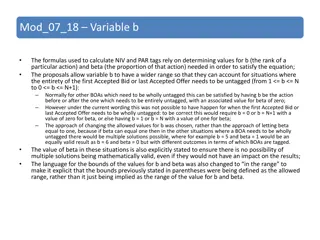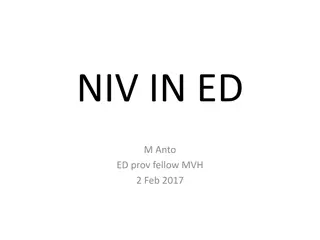
Non-Invasive Ventilation (NIV) in Medical Treatments
Explore the definition, uses, and indications of Non-Invasive Ventilation (NIV), a breathing support method applied through masks without the need for tracheal intubation. Learn about its applications in acute respiratory failure, COPD exacerbations, heart failure, and even in the context of COVID-19 treatment. Discover how NIV can be beneficial for long-term management in conditions like severe COPD, neuromuscular diseases, and obesity hypoventilation syndrome.
Download Presentation

Please find below an Image/Link to download the presentation.
The content on the website is provided AS IS for your information and personal use only. It may not be sold, licensed, or shared on other websites without obtaining consent from the author. If you encounter any issues during the download, it is possible that the publisher has removed the file from their server.
You are allowed to download the files provided on this website for personal or commercial use, subject to the condition that they are used lawfully. All files are the property of their respective owners.
The content on the website is provided AS IS for your information and personal use only. It may not be sold, licensed, or shared on other websites without obtaining consent from the author.
E N D
Presentation Transcript
StudyMafia.Org Non-Invasive Ventilation (NIV) Submitted To: Submitted By: Studymafia.org Studymafia.org
Table Contents Definition Introduction Uses of NIV Indcations of NIV Conclusion 2
Definition Non-invasive ventilation (NIV) is the use of breathing support administered through a face mask, nasal mask, or a helmet. 3
Introduction Air, usually with added oxygen, is given through the mask under positive pressure; generally the amount of pressure is alternated depending on whether someone is breathing in or out. It is termed "non-invasive" because it is delivered with a mask that is tightly fitted to the face or around the head, but without a need for tracheal intubation (a tube through the mouth into the windpipe). 4
Uses of Non-Invasive Ventilation NIV for acute respiratory failure is used particularly for severe exacerbations of chronic obstructive pulmonary disease (COPD) but also for acute decompensated heart failure and other acute conditions. NIV can be used acutely and long-term. In some people who have presented with acute respiratory failure, there is an ongoing need for long-term use of NIV at home. 6
Uses of Non-Invasive Ventilation Non-invasive ventilation has been suggested in the treatment for coronavirus disease 2019 (COVID-19) where shortages of invasive ventilation equipment and facilities may arise. The risk of poorly fitting masks emitting aerosols can require full protection gear for caregivers. 7
Uses of NIV Chronic use of NIV ("home NIV") may be indicated for severe COPD. A review from 2021 demonstrated that the chronic use of non- invasive ventilation improves daytime hypercapnia, In addition, in stable chronic obstructive pulmonary disease, survival seems to be improved and there might be a short term benefit of health-related quality of life. 8
Uses of NIV Home NIV may also be indicated in people with neuromuscular disease and chest wall deformity. People with obesity hypoventilation syndrome often require NIV initially in their care, but many can be switched to CPAP. American Thoracic Society (ATS) clinical practice guidelines recommend that NIV is provided on discharge with a further sleep study assessment as an outpatient.[ 9
Indication The most common indication for acute non- invasive ventilation is for acute exacerbation of chronic obstructive pulmonary disease. The decision to commence NIV, usually in the emergency department, depends on the initial response to medication (bronchodilators given by nebulizer) and the results of arterial blood gas tests. 10
Indication If after medical therapy the lungs remain unable to clear carbon dioxide from the bloodstream (respiratory acidosis), NIV may be indicated. Many people with COPD have chronically elevated CO2 levels with metabolic compensation, but NIV is only indicated if the CO2 is acutely increased to the point that the acidity levels of the blood are increased (pH<7.35). 11
Indication There is no level of acidity above which NIV cannot be started, but more severe acidosis carries a higher risk that NIV alone is not effective and that mechanical ventilation will be required instead. 12
Conclusion Non-invasive ventilation (NIV) refers to the provision of ventilatory support through the patient's upper airway using a mask or similar device. This technique is distinguished from those which bypass the upper airway with a tracheal tube, laryngeal mask, or tracheostomy and are therefore considered invasive. 14
References Google.com Wikipedia.org Studymafia.org Slidespanda.com
Thanks To StudyMafia.org







